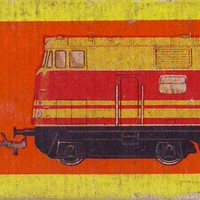This site is about overhauling an old Piko locomotive and converting it to digital operation. I hope you find it useful.
The main problem with this locomotive was that electric contact on the wheels became quite unreliable (possibly due to damage caused by my previous meddling) but I also wanted to replace the crude circuit board I made when fitting the loco with a NEM652 socket.
I began by getting a suitable smaller motor to replace the bulky "cube-motor", this freed up a little space inside and made the loco run quiter and smoother. The new wheel contacts are made from old guitar strings soldered to pieces of etched circuit board. These replaced the plastic frame holding the original contacts, which was broken.
I made a third circuit board for the decoder socket and other electrical components. The socket was made using pieces of breakable IC socket strip. First I drilled eight holes aligned in a 2x4 grid using a piece of perfboard (stuck to the blank circuit board with double-sided tape) as a template, then bored them to a 2 mm diameter. I etched the circuit boards with ferric chloride, using a permanent marker to draw traces on the blank (I recommend testing on a scrap piece of circuit board as some markers don't work that well). After that I cut the black plastic and the pins off eight sockets from the socket strip, and pushed the individual metal pieces into the holes. I then soldered them to the circuit board, and added the other components (diodes for directional light in analog operation, filtering inductors and capacitor and one lightbulb). I finished by soldering the wires in place, colour-coding them according to the NEM652 standard.
After a test run, the locomotive was reassembled and works well ever since, although it is still sensitive to dirt on the track or its wheels.










